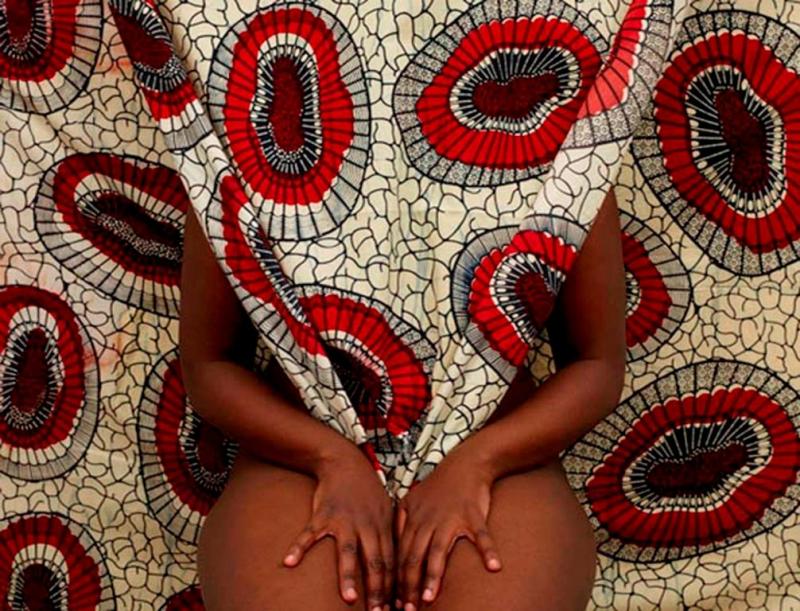Cotton: Global Threads, Whitworth Art Gallery | reviews, news & interviews
Cotton: Global Threads, Whitworth Art Gallery
Cotton: Global Threads, Whitworth Art Gallery
An exhibition exploring the importance of cotton as a global commodity could have given us more of a history lesson

Manchester was once known as Cottonopolis, since the city was once at the centre of the vast global industry reponsible for its growth and prosperity.The Whitworth Art Gallery, which is part of Manchester University, has in its collection a wealth of textiles, providing not just a colourful history of local cotton manufacture, but tracing the trade’s international links.
The exhibition provokes questions surrounding the ethical production of what had become, by the end of the 19th century, the most ubiquitous natural fibre in the world. In 1790 cotton accounted for just 4 per cent of all clothing in Europe and America; by 1890 that figure had risen to 73 per cent. The invention of new technologies in weaving and spinning heralded England’s industrial revolution. But such a rise, inevitably, came at a human cost. This cost is explored in this exhibition - though, with the involvement of local school groups, it can at times feel just a little too much like an extended school project.
Cottonopolis is one work by teenagers who visited Ahmedabad, India’s current cotton capital. With artist Sally Olding, the school group produced a printed woodblock model of a congested imaginary city that combines Manchester and the Gujarat capital. A nearby video shows one of the group observe that, unlike the local Ahmedabad population, the English seem not to be at all proud of their own heritage, nor particularly interested in their history. The emphasis on a global context illuminates this exhibition, but as one wanders through the displays the remark resonates: one might certainly have enjoyed more focus on the cotton industry as the catalyst for modern Britain.
 That said, there are some very enjoyable highlights among the works of the contemporary artists who have been specially commissioned for this exhibition. These showcase artists who not only use textiles in their work, but who have something to say about the polical and social ramifications of its use, though Yinka Shonibare’s presence, with his trademark batik fabric, is perhaps a little too predictable. Here we see an atlas globe (pictured right: Boy on Globe 4, 2011) suspended from a ceiling on which a headless figure in 18th-century dress appears to be losing his balance.
That said, there are some very enjoyable highlights among the works of the contemporary artists who have been specially commissioned for this exhibition. These showcase artists who not only use textiles in their work, but who have something to say about the polical and social ramifications of its use, though Yinka Shonibare’s presence, with his trademark batik fabric, is perhaps a little too predictable. Here we see an atlas globe (pictured right: Boy on Globe 4, 2011) suspended from a ceiling on which a headless figure in 18th-century dress appears to be losing his balance.
As most who are familiar with this artist’s work know, Shonibare uses brightly patterned prints which look native to West Africa but are manufactured in Holland – where they were originally produced – and bought by him in Brixton Market. The theme of cultural hybridity underpins this exhibition.

One captivating work belongs to British-Malian artist Grace Ndiritu. Her video work is a performance piece called Still Life (main picture) in which she uses sheets of beautifully printed West African cotton to conceal and reveal her body in a series of sinuous movements. Equally seductive is Liz Rideal’s Drop Sari (pictured above), a film that’s projected onto the exterior of the building at night. Inside, the film can be seen on a large screen as the centrepiece of the exhibition: inspired by 19th century Indian sample books, it shows a sequence of close-up shots of billowing drapery, removed from any context. Elsewhere, Lubaina Himid’s Kangas – pieces of printed fabric traditionally worn in West Africa but here based on designs the artist found in the Whitworth’s textile collection – have the appearance of functional items of clothing.
One non-contemporary highlight is the beautifully preserved 18th century handpainted cotton tent which once belonged to Tipu Shahib, the sultan of Mysore. The fabric is arranged across one wall, its repeated pattern of bright red flowers unfaded by time. Before Britain’s industrial revolution, India was the foremost producer of luxury textiles and cotton is inevitably tied up with India’s colonial past. Much later, cotton was to play a highly symbolic role in the struggle for independence. In the 1920s, Gandhi called for the boycott of British textiles and urged people to buy Indian-produced khadi (hand-spun, hand-woven cloth). A spinning wheel still adorns the Indian national flag.
Cotton has been hugely significant commodity in shaping the world as we know it today. Perhaps this exhibition might have given even more room to that fascinating history, rather than to some of the more interactive displays that can been seen alongside the artworks. Personally, I doubt if anyone will be game for trying on, in the dressing room provided, the “upcycled” clothes that are hanging in one section of the exhibition.
- Cotton: Global Threads at Whitworth Art Gallery, Manchester, until 13 May
rating
Explore topics
Share this article
The future of Arts Journalism
You can stop theartsdesk.com closing!
We urgently need financing to survive. Our fundraising drive has thus far raised £49,000 but we need to reach £100,000 or we will be forced to close. Please contribute here: https://gofund.me/c3f6033d
And if you can forward this information to anyone who might assist, we’d be grateful.

Subscribe to theartsdesk.com
Thank you for continuing to read our work on theartsdesk.com. For unlimited access to every article in its entirety, including our archive of more than 15,000 pieces, we're asking for £5 per month or £40 per year. We feel it's a very good deal, and hope you do too.
To take a subscription now simply click here.
And if you're looking for that extra gift for a friend or family member, why not treat them to a theartsdesk.com gift subscription?
more Visual arts
 'We are bowled over!' Thank you for your messages of love and support
Much-appreciated words of commendation from readers and the cultural community
'We are bowled over!' Thank you for your messages of love and support
Much-appreciated words of commendation from readers and the cultural community
 Photo Oxford 2025 review - photography all over the town
At last, a UK festival that takes photography seriously
Photo Oxford 2025 review - photography all over the town
At last, a UK festival that takes photography seriously
![SEX MONEY RACE RELIGION [2016] by Gilbert and George. Installation shot of Gilbert & George 21ST CENTURY PICTURES Hayward Gallery](https://theartsdesk.com/sites/default/files/styles/thumbnail/public/mastimages/Gilbert%20%26%20George_%2021ST%20CENTURY%20PICTURES.%20SEX%20MONEY%20RACE%20RELIGION%20%5B2016%5D.%20Photo_%20Mark%20Blower.%20Courtesy%20of%20the%20Gilbert%20%26%20George%20and%20the%20Hayward%20Gallery._0.jpg?itok=7tVsLyR-) Gilbert & George, 21st Century Pictures, Hayward Gallery review - brash, bright and not so beautiful
The couple's coloured photomontages shout louder than ever, causing sensory overload
Gilbert & George, 21st Century Pictures, Hayward Gallery review - brash, bright and not so beautiful
The couple's coloured photomontages shout louder than ever, causing sensory overload
 Lee Miller, Tate Britain review - an extraordinary career that remains an enigma
Fashion photographer, artist or war reporter; will the real Lee Miller please step forward?
Lee Miller, Tate Britain review - an extraordinary career that remains an enigma
Fashion photographer, artist or war reporter; will the real Lee Miller please step forward?
 Kerry James Marshall: The Histories, Royal Academy review - a triumphant celebration of blackness
Room after room of glorious paintings
Kerry James Marshall: The Histories, Royal Academy review - a triumphant celebration of blackness
Room after room of glorious paintings
 Folkestone Triennial 2025 - landscape, seascape, art lovers' escape
Locally rooted festival brings home many but not all global concerns
Folkestone Triennial 2025 - landscape, seascape, art lovers' escape
Locally rooted festival brings home many but not all global concerns
 Sir Brian Clarke (1953-2025) - a personal tribute
Remembering an artist with a gift for the transcendent
Sir Brian Clarke (1953-2025) - a personal tribute
Remembering an artist with a gift for the transcendent
 Emily Kam Kngwarray, Tate Modern review - glimpses of another world
Pictures that are an affirmation of belonging
Emily Kam Kngwarray, Tate Modern review - glimpses of another world
Pictures that are an affirmation of belonging
 Kiefer / Van Gogh, Royal Academy review - a pairing of opposites
Small scale intensity meets large scale melodrama
Kiefer / Van Gogh, Royal Academy review - a pairing of opposites
Small scale intensity meets large scale melodrama
 Jenny Saville: The Anatomy of Painting, National Portrait Gallery review - a protégé losing her way
A brilliant painter in search of a worthwhile subject
Jenny Saville: The Anatomy of Painting, National Portrait Gallery review - a protégé losing her way
A brilliant painter in search of a worthwhile subject
 Abstract Erotic, Courtauld Gallery review - sculpture that is sensuous, funny and subversive
Testing the boundaries of good taste, and winning
Abstract Erotic, Courtauld Gallery review - sculpture that is sensuous, funny and subversive
Testing the boundaries of good taste, and winning
 Edward Burra, Tate Britain review - watercolour made mainstream
Social satire with a nasty bite
Edward Burra, Tate Britain review - watercolour made mainstream
Social satire with a nasty bite

Add comment